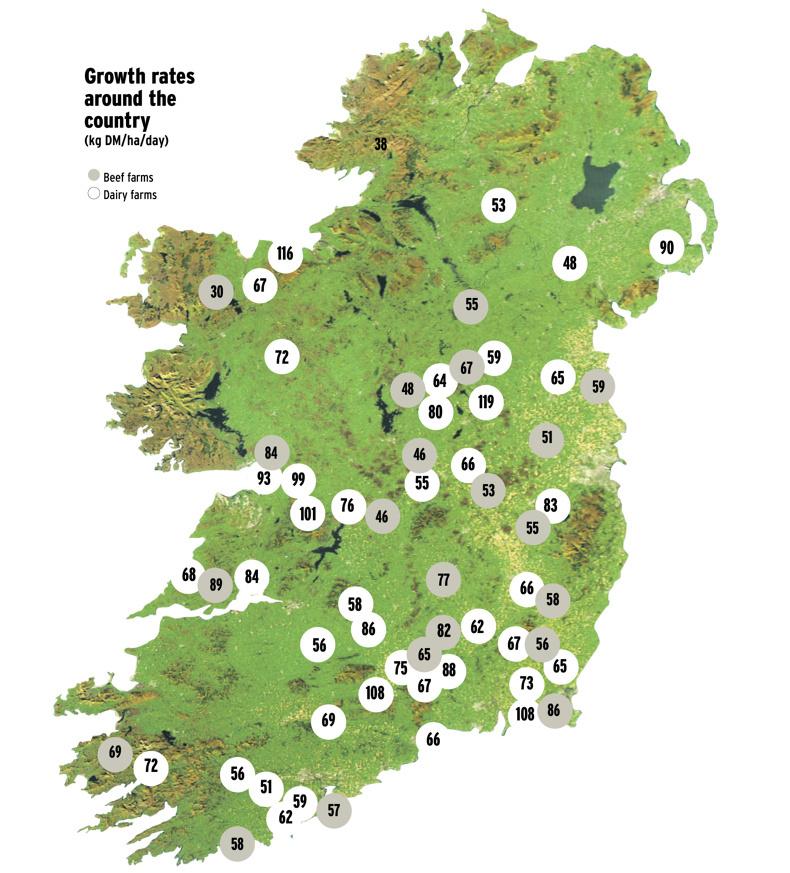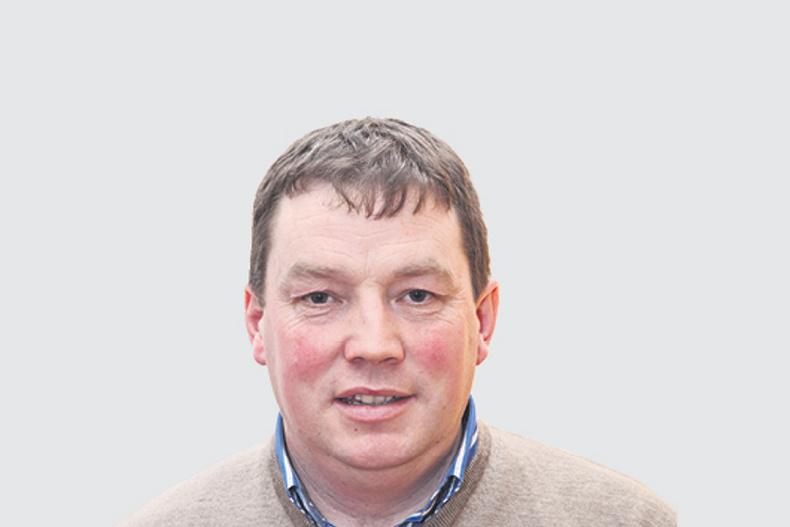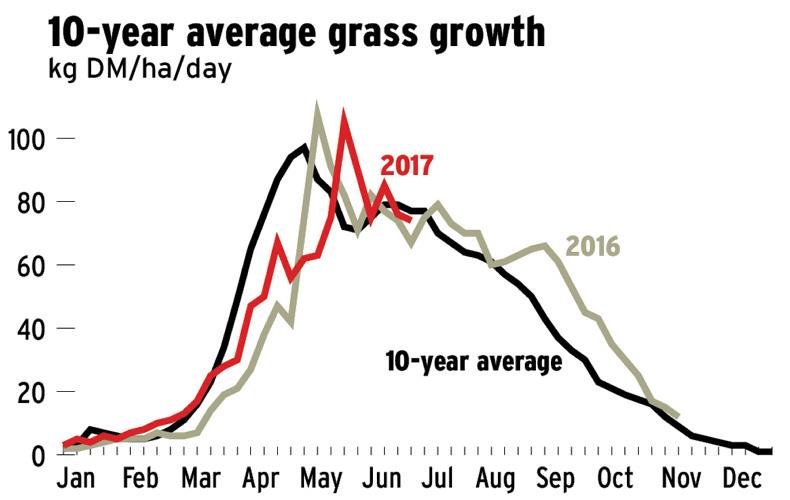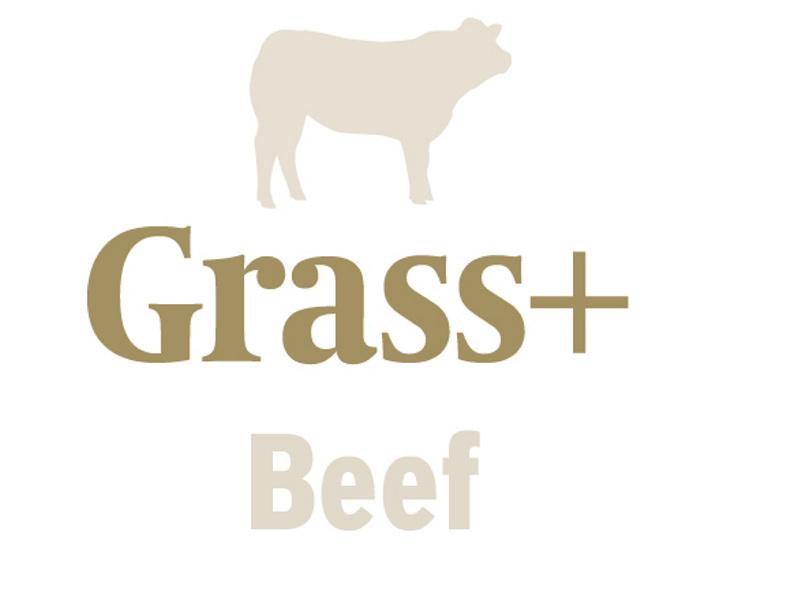Many farmers will think about spring grass supply next January or February. While there is a certain degree of unknowns around winter growth and weather conditions, there is a degree of planning that can go into place in the coming months to set the farm up for early turnout in February 2018. Building grass covers over the next few months will mean that housing can be planned and some grass can be carried over the winter months for grazing next spring. Plans need to be put in place as to what paddocks need to close first and what fertiliser needs to be spread to build grass covers.
Question – at what point in the year should our farm’s grass supply be at its highest?
No, it isn’t the springtime. Our farm should have its highest grass cover in mid-September. Second-cut silage ground is well and truly back in the mix, rotations lengthen and we are building a supply that will carry us into the back end and, crucially, allow us to set up for grazing the following spring. This is why thinking about grass in the spring is too late, grass needs to be built up when it is actually growing.
So, for those currently drowning in a sea of stem, the time for grassland new year’s resolutions is now. If you’ve got it in your mind that 2018 is your year for getting more from your grass, then the wheels need to start turning on this pronto.
What does this mean? Planning paddocks – how do I split my current fields in the best way?Drinkers – where can they be best placed? Soil fertility – what parts of the farm are slow to grow? Drainage – should I do it now while land is trafficable? Ask any serious grass farmer who took the plunge and addressed these issues and their only regret will be that they didn’t do it sooner.
Often, taking the first steps is a daunting prospect and puts many off – ‘where do I start?’
If you would like help with this, do not hesitate to email us.


Co Mayo
System suckler to bull beef
Soil type variable
Avg farm cover (kg DM/ha) 1,449
Grass demand (kg DM/ha/day) 34
Growth (kg DM/ha/day) 30
Growth is back here over the last two weeks but I still have surplus grass. I’ve a very healthy average farm cover and, once the weather settles down, I’ll be taking out more paddocks for baled silage. It’s been a great year for grass and I’ve recently reseeded seven acres, deciding to go with an intensive silage mix. I hope to get two or even three cuts from this field going forward, as the ground is away from the farmyard.
I’ve been concentrating on P and K all year, targeting poorer performing paddocks with 18-6-12. Lime will be spread in the back-end, across the whole farm. My bulls will be going to the shed in August for finishing and as the demand for grass falls, I’ll close paddocks for next spring. The last of the slurry will go out later in the back-end, it worked well for me last year and most definitely helps build grass covers over the winter months. Poorer performing cows will be culled as I continue to tighten my calving spread.

Newford Herd, Co Galway
System suckler to steer beef
Soil type dry to heavy
Avg farm cover (kg DM/ha) 1,004
Grass demand (kg DM/ha/day) 67
Growth (kg DM/ha/day) 84
Utilisation has taken a hit on some parts of the farm, as a result of the cold nights and some heavy downpours. 24mm of rain fell last Monday (26 June). Since my last update, we have removed a further 13 acres as bales from grazing ground to keep tabs on grass quality. Cutting or grazing is being followed with CAN at a rate of one bag per acre at present.
The two stock bulls (SI & LM), which were turned out to the herd on Saturday 3 June to mop up after AI, were removed this week. Scanning of the herd will take place at the end of July
Our 47 bullocks were weighed on 22 June and tipped the scales at 500kg at 15 months of age, with a daily gain of 0.99kg since birth. They have put on 1.3kg daily since their last weigh in (37 days). The 42 heifers weighed 463kg (0.91kg daily gain since birth).
As for the 2017-born calves, bulls now weigh 196kg, averaging growth of 1.3kg daily form birth. The heifers are currently gaining 1.24kg daily and weigh 178kg.

Co Limerick
System suckler to weanling
Soil type mixed
Avg farm cover (kg DM/ha) n/a
Grass demand (kg DM/ha/day) n/a
Growth (kg DM/ha/day) n/a
I am currently taking out paddocks that are getting too strong. So far, I have 110 bales taken as surplus and more will follow. I have 14 acres closed for second cut. I find the bales a much more flexible option to pit with regards having both quality and quantity. I have cut back on fertiliser usage for the moment, to avoid having too large a surplus of bales. I will spread nitrogen again in late-July to begin planning for autumn-grazing and build covers for next spring. While I am lowly stocked this year, due to having a large number of young calves on the ground, I plan to use this year to improve my soil fertility and grazing infrastructure so as to be ready to carry a higher stocking rate next year, when these calves mature and will eat proper grass.
I have dosed all calves for worms recently using a white drench. I may give a second dose in August depending on faecal sample results.

Co Carlow
System suckler to store
Soil type free draining
Avg farm cover (kg DM/ha) 701
Grass demand (kg DM/ha/day) 33
Growth (kg DM/ha/day) 58
Although growth has slowed in recent weeks, there is still a good quantity of grass at present on the farm. Last week, the entire farm got 20 units of nitrogen in the form of CAN. Over the last few weeks, I managed to take surplus bales off a number of paddocks and with application of fertilizer. I hope it will allow me to take out more bales in the coming weeks. The second-cut silage will be ready for harvesting in the next 10 days. I was disappointed with how it grew but it looks to be good quality grass. Over the last few days, I have a lot of drainage work done on a particularly wet paddock to allow me to get better use out of it during wet times of the year. This paddock will also be reseeded in the next few weeks. All stock are doing well, steers were weighed three weeks ago and I was happy with the performance to date. Calves were treated for lung worm last week and this week all the yearlings will get a dose.

Read more
Beef management : fodder budgeting
Grass+ dairy: growth differs as moisture levels vary
Many farmers will think about spring grass supply next January or February. While there is a certain degree of unknowns around winter growth and weather conditions, there is a degree of planning that can go into place in the coming months to set the farm up for early turnout in February 2018. Building grass covers over the next few months will mean that housing can be planned and some grass can be carried over the winter months for grazing next spring. Plans need to be put in place as to what paddocks need to close first and what fertiliser needs to be spread to build grass covers.
Question – at what point in the year should our farm’s grass supply be at its highest?
No, it isn’t the springtime. Our farm should have its highest grass cover in mid-September. Second-cut silage ground is well and truly back in the mix, rotations lengthen and we are building a supply that will carry us into the back end and, crucially, allow us to set up for grazing the following spring. This is why thinking about grass in the spring is too late, grass needs to be built up when it is actually growing.
So, for those currently drowning in a sea of stem, the time for grassland new year’s resolutions is now. If you’ve got it in your mind that 2018 is your year for getting more from your grass, then the wheels need to start turning on this pronto.
What does this mean? Planning paddocks – how do I split my current fields in the best way?Drinkers – where can they be best placed? Soil fertility – what parts of the farm are slow to grow? Drainage – should I do it now while land is trafficable? Ask any serious grass farmer who took the plunge and addressed these issues and their only regret will be that they didn’t do it sooner.
Often, taking the first steps is a daunting prospect and puts many off – ‘where do I start?’
If you would like help with this, do not hesitate to email us.


Co Mayo
System suckler to bull beef
Soil type variable
Avg farm cover (kg DM/ha) 1,449
Grass demand (kg DM/ha/day) 34
Growth (kg DM/ha/day) 30
Growth is back here over the last two weeks but I still have surplus grass. I’ve a very healthy average farm cover and, once the weather settles down, I’ll be taking out more paddocks for baled silage. It’s been a great year for grass and I’ve recently reseeded seven acres, deciding to go with an intensive silage mix. I hope to get two or even three cuts from this field going forward, as the ground is away from the farmyard.
I’ve been concentrating on P and K all year, targeting poorer performing paddocks with 18-6-12. Lime will be spread in the back-end, across the whole farm. My bulls will be going to the shed in August for finishing and as the demand for grass falls, I’ll close paddocks for next spring. The last of the slurry will go out later in the back-end, it worked well for me last year and most definitely helps build grass covers over the winter months. Poorer performing cows will be culled as I continue to tighten my calving spread.

Newford Herd, Co Galway
System suckler to steer beef
Soil type dry to heavy
Avg farm cover (kg DM/ha) 1,004
Grass demand (kg DM/ha/day) 67
Growth (kg DM/ha/day) 84
Utilisation has taken a hit on some parts of the farm, as a result of the cold nights and some heavy downpours. 24mm of rain fell last Monday (26 June). Since my last update, we have removed a further 13 acres as bales from grazing ground to keep tabs on grass quality. Cutting or grazing is being followed with CAN at a rate of one bag per acre at present.
The two stock bulls (SI & LM), which were turned out to the herd on Saturday 3 June to mop up after AI, were removed this week. Scanning of the herd will take place at the end of July
Our 47 bullocks were weighed on 22 June and tipped the scales at 500kg at 15 months of age, with a daily gain of 0.99kg since birth. They have put on 1.3kg daily since their last weigh in (37 days). The 42 heifers weighed 463kg (0.91kg daily gain since birth).
As for the 2017-born calves, bulls now weigh 196kg, averaging growth of 1.3kg daily form birth. The heifers are currently gaining 1.24kg daily and weigh 178kg.

Co Limerick
System suckler to weanling
Soil type mixed
Avg farm cover (kg DM/ha) n/a
Grass demand (kg DM/ha/day) n/a
Growth (kg DM/ha/day) n/a
I am currently taking out paddocks that are getting too strong. So far, I have 110 bales taken as surplus and more will follow. I have 14 acres closed for second cut. I find the bales a much more flexible option to pit with regards having both quality and quantity. I have cut back on fertiliser usage for the moment, to avoid having too large a surplus of bales. I will spread nitrogen again in late-July to begin planning for autumn-grazing and build covers for next spring. While I am lowly stocked this year, due to having a large number of young calves on the ground, I plan to use this year to improve my soil fertility and grazing infrastructure so as to be ready to carry a higher stocking rate next year, when these calves mature and will eat proper grass.
I have dosed all calves for worms recently using a white drench. I may give a second dose in August depending on faecal sample results.

Co Carlow
System suckler to store
Soil type free draining
Avg farm cover (kg DM/ha) 701
Grass demand (kg DM/ha/day) 33
Growth (kg DM/ha/day) 58
Although growth has slowed in recent weeks, there is still a good quantity of grass at present on the farm. Last week, the entire farm got 20 units of nitrogen in the form of CAN. Over the last few weeks, I managed to take surplus bales off a number of paddocks and with application of fertilizer. I hope it will allow me to take out more bales in the coming weeks. The second-cut silage will be ready for harvesting in the next 10 days. I was disappointed with how it grew but it looks to be good quality grass. Over the last few days, I have a lot of drainage work done on a particularly wet paddock to allow me to get better use out of it during wet times of the year. This paddock will also be reseeded in the next few weeks. All stock are doing well, steers were weighed three weeks ago and I was happy with the performance to date. Calves were treated for lung worm last week and this week all the yearlings will get a dose.

Read more
Beef management : fodder budgeting
Grass+ dairy: growth differs as moisture levels vary












 This is a subscriber-only article
This is a subscriber-only article












SHARING OPTIONS: